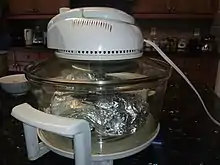Beggar's chicken
Beggar's chicken is a Chinese dish of chicken that is stuffed, wrapped in clay and lotus leaves (or banana or bamboo leaves as alternatives), and baked slowly using low heat. Preparation of a single portion may take up to six hours. Although the dish is traditionally prepared with clay, the recipe has evolved; for convenience and safety it is often baked with dough, oven bags, ceramic cooking pots, or convection ovens.
._(2).jpg.webp) A dish of beggar's chicken, prepared in California | |
| Alternative names | Rich and noble chicken Baked stuffed chicken Hangzhou simmer chicken Yellow mud simmer chicken Foiled chicken (a simplified version) |
|---|---|
| Type | Stuffed chicken dish |
| Place of origin | China |
| Region or state | Changshu, Jiangsu province |
| Main ingredients | Chicken, marinade, and stuffing with variety of ingredients |
| Beggar's chicken | |||||||||||
|---|---|---|---|---|---|---|---|---|---|---|---|
| Traditional Chinese | 叫化雞 | ||||||||||
| Simplified Chinese | 叫化鸡 | ||||||||||
| Hanyu Pinyin | jiàohuā jī | ||||||||||
| Literal meaning | beggar's chicken | ||||||||||
| |||||||||||
Origin
Beggar's chicken is very popular in China, with many regions claim it as traditionally their own.[1] Most experts agree the dish originated in Hangzhou.[1][2] The clay-wrapped method of slow cooking is thousands of years old.[1]
Various legends surround the origins of beggar's chicken.[3][4] In one, a beggar stole a chicken from a farm but having no pot or utensils, he wrapped the bird in lotus leaves and packed clay or mud around it, set it in a hole where he had lit a fire, and buried it. When he dug up the chicken and cracked open the clay, he found the meat was tender and aromatic.[1][2] In other versions, the beggar stole the chicken from the emperor and used the mud-hole method to avoid smoke that might attract the imperial guards.[1] Alternatively, the emperor stopped to dine with the beggar and so enjoyed the dish that he added it to the imperial menu and the beggar prospered by selling the dish to locals.[2] According to another legend, the dish was a childhood favorite of Emperor Gaozu of Han, who had been born a peasant. When he became emperor, the recipe became an imperial specialty.[1]
Preparation
Today, dough is sometimes substituted for clay for the dish's preparation,[5][6][7][8] though some recipes still call for a covering of non-toxic clay to retain moisture,[9][10][11][12] and stuffed with various ingredients. It can be prepared in ovens, outdoor grills and smokers, and campfires. Non-toxic clay for preparing beggar's chicken can be obtained from hardware or arts and craft stores; however, cooks must pay attention when baking the dish with clay because if too much heat is used, "the earth may crack and it can be very dangerous" due to the pressure buildup in the clay shell.[13] Preparing the dish with dough is safer; ceramic cooking pots can also be used to retain moisture, but these are expensive to purchase.[14] Alternatively, an oven bag can be used[15][16] when cooking it in a domestic oven.

A convection oven can eliminate the need to cover the dish and allows it to cook evenly, but the chicken should still be wrapped with lotus leaves and sheets of aluminum foil, and would be ready in less time than in an electric oven. This simplified version of the dish is also called "foiled chicken".[17]
See also
References
- Basler, Barbara (April 8, 1990). "FARE OF THE COUNTRY; Hong Kong's Mystery Chicken". The New York Times. Retrieved 11 September 2017.
- "Beggar's Chicken: the Legend Behind the Dish". Four Seasons Hotel. Archived from the original on June 22, 2016. Retrieved 11 September 2017.
- Parkinson, Rhonda (June 1, 2015). "Chinese Recipe Name Origins". The Spruce. Retrieved March 21, 2014.
- Jun, Shi. "Beggar's Chicken (叫化鸡)". foreignercn.com. Retrieved April 5, 2012.
- "Beggar's Chicken (Jiao Hua Ji)". Saveur. March 20, 2002. Retrieved March 21, 2014.
- Yin-Fei Lo, Eileen (February 2004). The Chinese Chicken Cookbook: 100 Easy-to-Prepare, Authentic Recipes for the American Table (1st ed.). New York City, NY: Simon & Schuster. pp. 45–46. ISBN 9780743233415.
- Liaw, Adam. "Adam Liaw's beggar's chicken recipe". The Guardian. Guardian News & Media Limited. Retrieved 7 March 2019.
- "BEGGARS CHICKEN". COOKS.COM. The FOURnet Information Network. Retrieved 13 March 2019.
- Tan, Ken. "Beggar's Chicken". Taste by Four Seasons. Archived from the original on 2016-03-04. Retrieved 2014-03-22.
- "Beggars Chicken, Hangzhou Style". Flavor and Fortune. Retrieved 11 March 2019.
- Kian, Lam Kho. "Beggar's chicken, Clay, Grill!". Red Cook. Kian Lam Kho. Retrieved 11 March 2019.
- Pierre Franey; Craig Claiborne. "Beggar's Chicken". The New York Times. The New York Times. Retrieved 13 March 2019.
- Cai (蔡), Jieyi (潔儀) (July 2007). Classic Hong Kong Delicacies (懷舊酒家菜) (in Chinese). Hong Kong: Seaside Publications Company (海濱圖書公司). p. 68. ISBN 9789882024625.
- Gail Forman. "Beggar's Banquet". Washington Post. Washington Post. Retrieved 27 February 2019.
- "Oven Bags". Reynolds Kitchens. Reynolds Consumer Products. Retrieved 26 February 2019.
- "Beggar's Chicken". La Belle Cuisine. Crossroads International. Retrieved 27 February 2019.
- Lee, Mu-Tsun (2003). Chinese Cooking Made Easy with simple sauces and dressing (in Chinese) (13 ed.). Taipei, Taiwan: Wei-Chuan Cookbook. p. 19. ISBN 0941676269.